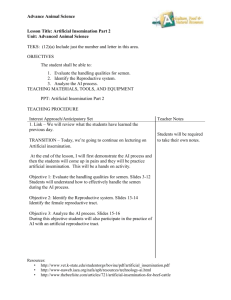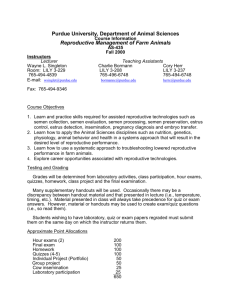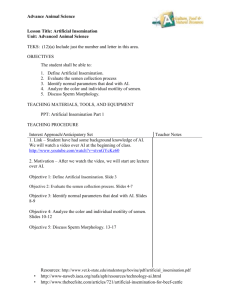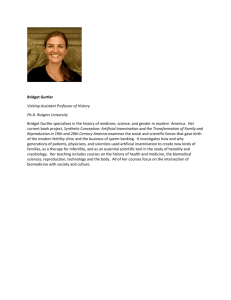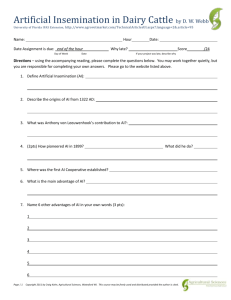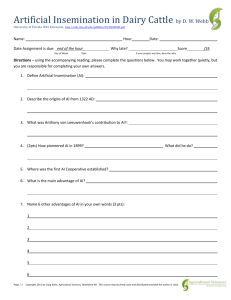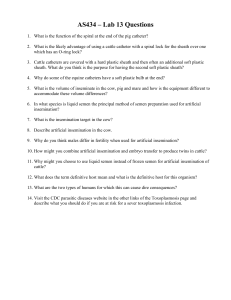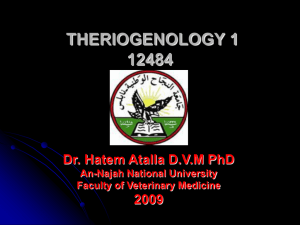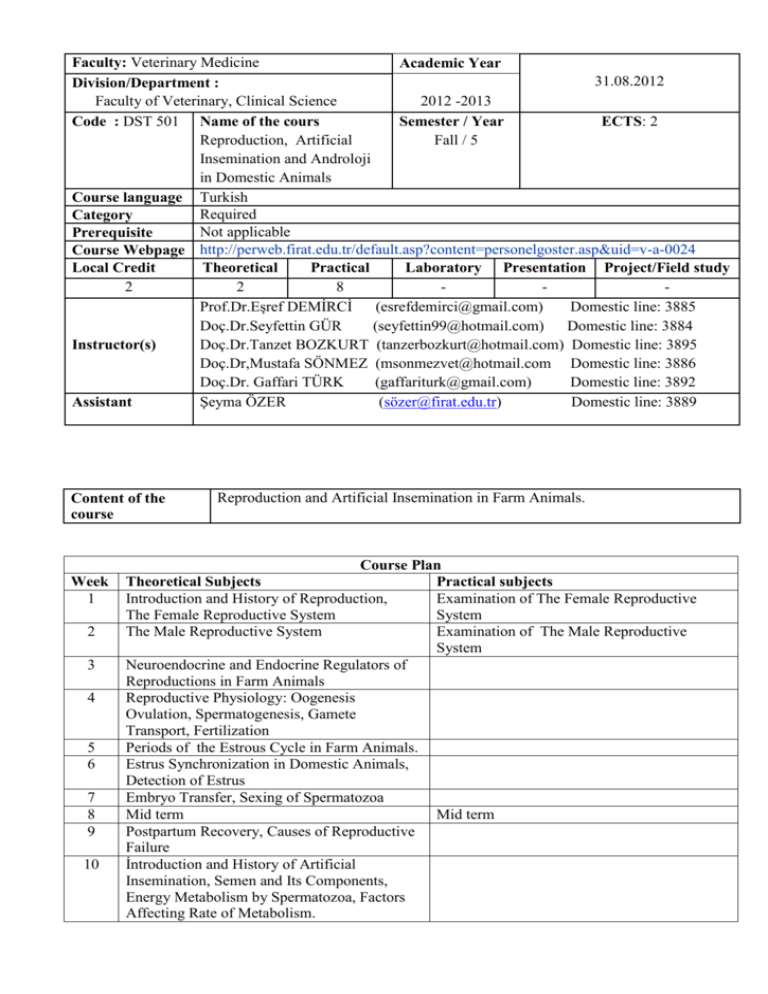
Faculty: Veterinary Medicine
Academic Year
31.08.2012
Division/Department :
Faculty of Veterinary, Clinical Science
2012 -2013
Code : DST 501 Name of the cours
ECTS: 2
Semester / Year
Reproduction, Artificial
Fall / 5
Insemination and Androloji
in Domestic Animals
Course language Turkish
Required
Category
Not applicable
Prerequisite
Course Webpage http://perweb.firat.edu.tr/default.asp?content=personelgoster.asp&uid=v-a-0024
Local Credit
Theoretical
Practical
Laboratory Presentation Project/Field study
2
2
8
Prof.Dr.Eşref DEMİRCİ
(esrefdemirci@gmail.com)
Domestic line: 3885
Doç.Dr.Seyfettin GÜR
(seyfettin99@hotmail.com)
Domestic line: 3884
Doç.Dr.Tanzet BOZKURT (tanzerbozkurt@hotmail.com) Domestic line: 3895
Instructor(s)
Doç.Dr,Mustafa SÖNMEZ (msonmezvet@hotmail.com Domestic line: 3886
Doç.Dr. Gaffari TÜRK
(gaffariturk@gmail.com)
Domestic line: 3892
Şeyma ÖZER
(sözer@firat.edu.tr)
Domestic line: 3889
Assistant
Content of the
course
Week
1
2
3
4
5
6
7
8
9
10
Reproduction and Artificial Insemination in Farm Animals.
Course Plan
Theoretical Subjects
Practical subjects
Introduction and History of Reproduction,
Examination of The Female Reproductive
The Female Reproductive System
System
The Male Reproductive System
Examination of The Male Reproductive
System
Neuroendocrine and Endocrine Regulators of
Reproductions in Farm Animals
Reproductive Physiology: Oogenesis
Ovulation, Spermatogenesis, Gamete
Transport, Fertilization
Periods of the Estrous Cycle in Farm Animals.
Estrus Synchronization in Domestic Animals,
Detection of Estrus
Embryo Transfer, Sexing of Spermatozoa
Mid term
Mid term
Postpartum Recovery, Causes of Reproductive
Failure
İntroduction and History of Artificial
Insemination, Semen and Its Components,
Energy Metabolism by Spermatozoa, Factors
Affecting Rate of Metabolism.
11
12
13
14
15
Methods of Semen Collections in Domestic
Animals
Semen Examination and Evaluation. Progeny
Test.
Importance and Properties of Semen Diluters.
Semen Dilution, Freezing, Storage.
Examination of the frozen semen, Preparation
of the inseminating straw gun.
Artificial Insemination Techniques in Domestic
Animals.
Text book(s)
Reference books
Semen Collections From The Bull, Stallion,
Ram Dog v.s.
Microscopic examination of semen
Preparation of the Semen Diluters
1- Prof. Dr. Eşref DEMİRCİ (2007) Evcil Hayvanlarda Reproduksiyon, Suni
Tohumlama ve Androloji Ders Notları. Fırat Üniv. Veteriner Fakültesi Yayınları
No: 53 Elazığ
1- Hafez,ESE. (2000) REPRODUCTİON İN FARM ANİMALS.7th ed Williams and
Wilkins, Lippincott, USA
2- H.Joe Bearden, Joh W. Fuquay, Scott T. Willard. (1980) Applied Animal Reproduction. 6th Edition, Mississippi State University, Pearson Prentice Hall. New Jersey.
Assessment
Number
Mid term
Pop-quiz
Homework
Projects
Term project
Laboratory
Others
Final exam
1
1
Contribution to
GPA(%)
40
60
About assessment
criteria
Contribution of
the contents (%)
Medical Sciences
Engineering
General Sciences
Social sciences
100
-
Learning
Outcomes
Goals
To give essential information to student about reproduction, artificial insemination
and andrology in farm animals.
Perpetuation of the Species :The strongest desire of an individual in any species is
to maintain itself. The strongest impulse in an individual is saving own life.
Reproduction is nature’s second strongest impulse, thus, the maintenance of the
species.
To provide food : Humans have learned to manage both domestic and wild species
so that surplus animals may be harvested to supply meat. Through selection, they
Course Format
have developed the milk-producing capabilities of a few species, so that milk, too,
has become an important link in the human food chain. Reproduction is essential for
the maintenance and continuity of nature’s food chain as well.
Genetic improvement: The management and alterations of natural reproductive
processes have been utilized as genetic tools.
Oral and Practical
Relation between the learning and program outcomes
Outputs
1
2
3
1
2
Contribution : 1: None 2: Partially 3: Completely
Prepared by: Prof. Dr. Eşref DEMİRCİ
Date of preparation: 31.08.2012

